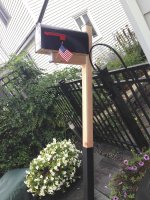Packard
Member
I went to Home Depot yesterday and bought some P/T decking and two 4” x 4” x 8’ posts.
They were very green and very wet (and very heavy).
Later in the day, after placing the P/T lumber on my deck for use the following day, I saw that I had a nasty purple rash on my hands and forearms.
A shower and some cortisone cream addressed the issue and the rash is gone this morning.
I will be using gloves and eye protection (and probably a face mask) when I resume the repair work.
I never had this issue in the past. Did they change the formulation again?
In any case, wear skin protection, eye protection and probably a face mask when using P/T (and keep some cortisone cream in the medicine cabinet.
They were very green and very wet (and very heavy).
Later in the day, after placing the P/T lumber on my deck for use the following day, I saw that I had a nasty purple rash on my hands and forearms.
A shower and some cortisone cream addressed the issue and the rash is gone this morning.
I will be using gloves and eye protection (and probably a face mask) when I resume the repair work.
I never had this issue in the past. Did they change the formulation again?
In any case, wear skin protection, eye protection and probably a face mask when using P/T (and keep some cortisone cream in the medicine cabinet.

